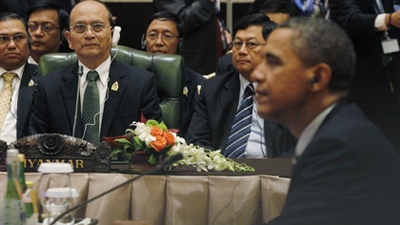Senior US administration officials give a briefing to reporters on American President Barack Obama’s announcement on Friday in Bali that he will send Secretary of State Hillary Clinton to Burma on Dec.1 for a two-day visit. Hillary Clinton is scheduled to hold talks with Burmese President Thein Sein and opposition leader Aung San Suu Kyi in this first visit to the country by a US secretary of state since military rule was first imposed nearly 50 years ago.
Released by the White House on Friday, the full text of the briefing on Burma by senior US Administration officials appears below.
Senior US administration official: Just to give you a bit of background -- this comes after many months of engagement between the United States and Burma, which we can speak to.
The President, of course, had a policy of maintaining the very strong pressure that we apply on the Burmese government while also testing engagement. And we felt that this was an appropriate step given the movement by the Burmese government in a range of areas that we can discuss.
 |
| U.S President Barack Obama sits alongside Burmese President Thein Sein in a US-Asean meeting in Nusa Dua, Bali on Nov 18. (Photo: Reuters) |
The only piece I'll just start with as relates to the President, he's been regularly briefed on this for some time now; he's discussed this with Secretary Clinton for some weeks now. The final piece as far as we were concerned that was very important to take place was for him to be able to call Aung San Suu Kyi last night to confirm that she was supportive of this engagement. He called her from Air Force one. He had a very substantive discussion with her where she was able to update him on her view of the political situation within Burma. And again, my colleagues can speak to that as well.
The President, I have to say, was very -- this was his first conversation with Aung San Suu Kyi. He was very struck by both her substantive observations and her warmth. As he said to us, he has great -- and as he said to her, he's long been a great admirer of hers for her struggle for democracy and human rights, and so it was a particularly meaningful conversation for the President -- but also a friendly one. She even asked the President how Bo, the dog, was doing. (Laughter.) So they were able to have a light series of moments as well.
But with that, I'll turn it over to my colleague to give you a little more background and then --
Q: How long was the call?
Senior US administration official: I think it was about 20 minutes -- 20 minutes or so.
Senior US administration official: Well, I can corroborate the reference to the dog. She asked after the family, asked after Bo, and said that she had a dog herself. But we'll have to wait until the next installment to find our more about her dog. (Laughter.)
The President began, as you just heard, by expressing his great personal admiration for her for her commitment to democracy, to political freedom and to human rights, and indicated that he wanted to consult with her on the significance of the developments over the past few months in Burma and solicit her ideas and thoughts about the best approach. He made very clear that our goal is to see a Burma that's responsive to the will of the people and needs of the people of Burma, and one that promotes the well-being of all of the diverse peoples in that country.
She talked with the President about the developments and emphasized the importance of a reconciliation process in Burma that is fully inclusive. She encouraged the President to make clear to Burma's leaders that the U.S. will be willing to work with them if they are, in fact, demonstrating that they are willing to work with the world and with her.
She advised the President that it is valuable and important for there to be direct lines of clear communication between the U.S. and the leadership in Burma. She strongly welcomed the prospect of a visit by Secretary Clinton for the purpose of increased dialogue and engagement both with her and her associates and with the government there.

